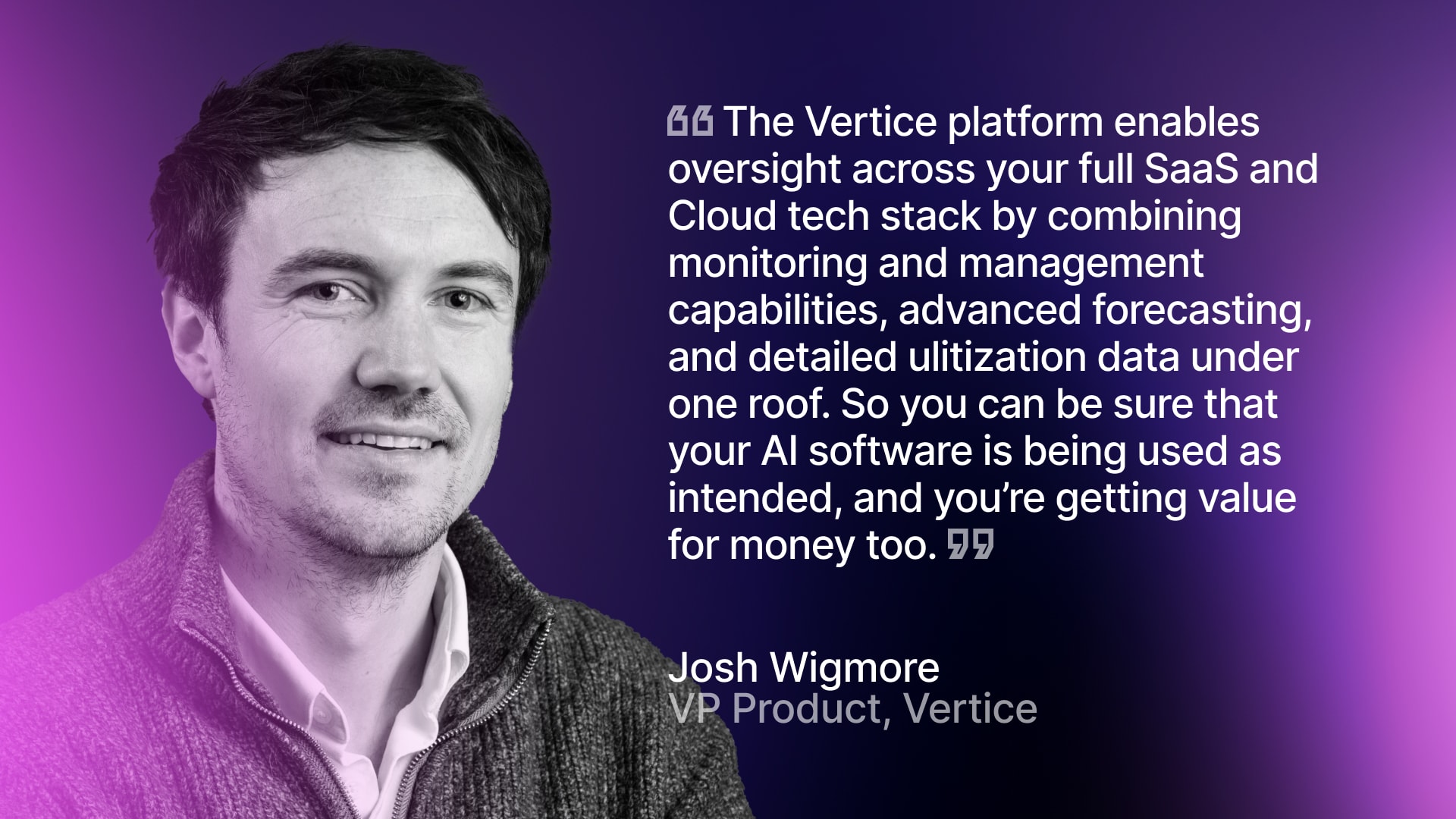5 predictions for the the continued rise of AI software in 2024
Matt Parsloe | JAN 18, 2024
10 min read
Frankly, it’s surprising that ‘AI’ wasn’t the Oxford English Dictionary’s coveted Word of the Year for 2023. It’s hardly been out of the news thanks to its nuclear growth over the past 12 months. From the feverish arrival of ChatGPT to the “will-they, won’t-they” saga of Sam Altman and Open AI, it’s stoked more discussion than the day after the office Christmas party.
AI has had soaring successes in 2023, with big tech players launching their AI offerings such as Amazon’s Bedrock, Microsoft’s Copilot, and Google’s Vertex AI. But it also suffered some setbacks towards the end of the year. There are significant lawsuits being filed against Microsoft and Open AI for copyright infringement related to how ChatGPT was trained, and there is a growing clamour for tighter regulation amidst stark warnings about the dangers of unchecked AI.
So, what does this mean for 2024? Is AI a funky trend, doomed to fade away and be replaced, or is the only way up? We’ve put together our thoughts for the future of AI in 2024.
Enterprise businesses will heavily invest in AI
Our research shows that total SaaS spend for AI tripled in the six months preceding October 2023. We know that software prices have increased thanks to inflation, but this accounts for a small part of the overall increase in spend on AI. Companies are investing in AI products to augment their current tech stacks at a rapid pace – especially as current products are iterated and improved and new AI tech comes on the market. Some are even predicting an increase in cloud and AI spending of up to 25% in 2024.
Bucking the trend of a more frugal 2023 overall, spending on AI ballooned in 2023.
This was particularly true of GenAI, which is predicted to achieve a CAGR of 73.3% per annum until 2027. In fact, the overall AI software market is expected to reach $307 billion by the same year. According to the IDC, enterprise companies will be the primary driver of this growth, accounting for 28.1% of overall AI spend by 2027, as opposed to just 9% in 2023. So for 2024, if the trend is steady rapid growth, expect it to hit 13.8%.
Why enterprise businesses?
They possess a potent combination of having the most spare capital for investment, and the ability to aggressively adopt, experiment and build out new tech with less overall risk. They also have the biggest capacity, and need, to build out data strategies that are both robust and supercharged to stay competitive.
AI business strategies will be key, though how these shape up is unclear. It’s yet to be seen if enterprise companies will take a targeted, iterative approach to onboarding new AI technologies, or invest heavily and see what sticks. Which makes sense, as there isn’t enough information available as to which products are the best for them, or whether certain products are cashing-in on hype over true benefits.
Strategizing for broad unknowns is also something that large-scale organisations tend to be averse to – it’s easier for them to jump in and see, rather than set a multi-year strategy that might go in completely the wrong direction. What we do know is, the money is there for 2024, so you might see some wildly different approaches to AI business strategy. Watch this space.
Usage-based pricing could initially be most popular when adopting AI
It’s rare that such a glut of new, unproven technologies hit the market at the same time. With little sign of rapid global economic recovery and lowered inflation, this could affect how companies want to pay for these AI products.
Remember: AI is a relatively new concept that has undergone extreme rapid growth, so it’s a victim of its own success when it comes to possessing a very limited track record. With AI startups and products becoming the boom industry of 2024 (see our 3rd prediction), companies will have a lot of choices, none of which will have true proof of concept. In short, implementing AI products into business processes is still a relative gamble.
Many SaaS vendors offer alternative pricing methods that aren’t advertised. One such option is usage-based pricing. This offers a way for businesses to bring in tech with little track record of corporate success whilst minimising financial risk. A subscription pricing model, on the other hand, tends to lock-in companies with large contracts and, for tech being adopted at an experimental stage, this immediately seems much less appealing.
2024 could see, according to a report by Snowflake, usage-based pricing being initially adopted as an entry-level model. Then, as the concept proves its viability, the company could move to a subscription payment system upon contract renegotiation.
2024 will be the boom year for AI startups – especially in security
From customer service chatbots to data entry and analysis through to marketing, there are almost endless AI possibilities. While the big tech providers are building and releasing their own AI tools, it’s a prime opportunity for startups to create plug-in products that serve specific needs. Murf, Lumen5 and Jasper.ai are great examples of these.
Into 2024, we expect a boom in AI startups thanks to the ever-increasing investment in the sector from enterprise companies. The agility and pace of startups will quickly service burgeoning enterprise needs, and therefore create a sector that is ripe with opportunity. Some startups and scaleups are even planning on challenging the tech giants rather than servicing them.
But perhaps the biggest sub-sector of AI in 2024 will be around AI security.
Why?
Because AI is in a precarious position in some respects. Yes, it has massive potential to transform how we work, but it also has the power to disrupt if it’s in the hands of bad actors. Having protection against AI-driven attempts to harm will be a top priority for those wishing to safeguard their business. It might even be that AI fights AI, with AI-powered security programmes combatting ever-learning AI attacks more quickly and effectively than standard security protocols.
Who will win? The unstoppable force or the immovable object?
Regulation around AI will tighten, including copyright law
We’ve all seen the news: a “father” of AI pops up and warns us all against the dangers of it going unchecked. And yes, we’ve all seen The Terminator. While we are far away from sentient robot armies fighting a single burly Austrian man, there is a growing nervousness around letting AI develop unrestricted.This is especially true in cybersecurity, the use of AI in military spheres, and in terms of legal rights.
2023 was the year in which the world sat up and took note. We’ve already seen Executive Orders issued in the US, the signing of the Bletchley Declaration, and world summits pulling together initial regulations and ringfences for AI development. As it continues to grow in importance and influence in 2024, we can surmise that more attempts to regulate will follow, especially considering the matter of AI security. In fact, many drafted documents surrounding AI safety and security — for example, the EU’s A.I Act — could be ratified in 2024, so keep an eye out for them.
Another interesting 2024 development will be around copyright law. There have already been lawsuits filed against GenAI and LLM companies regarding how they use published material to train themselves. Not only will these lawsuits create legal precedents that shape how AI is immediately built and used, but they will also necessitate the creation of global and national laws that govern this, too.
AI’s rapid rise and potential for explosive growth has drawn the world’s attention, and it seems it’s heading for an inevitable clash with guardrails, red tape and legal ease. Prepare the lawyers, although…
AI-automation could lead to cost savings planned for 2025, as well as job losses
While AI is being positioned as a work-enablement entity, there is still the looming spectre of job losses or roles being dramatically altered. Think about it — AI will help one person do the work of two or three, but what happens to the people whom it replaces? Will there be time to assimilate them into other parts of the company? Has this been strategised by companies keen to adopt AI tech? The fast-paced growth and adoption of AI products renders the answers to both as unlikely.
The trend seems to be moving towards AI replacing certain support roles, particularly copywriting (eek…), document drafting and some sections of customer support. So for all of those paralegals and lawyers drafting those lawsuits and documents to file against AI companies, you could get replaced by a tech stack of AI products who will do it for them! Oh, the irony.
Ultimately, cost-savings will be planned as a result of AI adoption, thanks to its immense capabilities. But where will these savings be reinvested – into more AI? Other areas of business growth? Re-training those displaced by AI tech? Usually, finance teams like to plan budgets and cost savings far ahead of time. But the pace of AI advancements, especially in areas like LLM, are unlikely to be steady and could make huge leaps in short spaces of time. This may necessitate more flexibility and fluidity in re-allocating and predicting cost-savings. Capital planned to be saved in 2025 as a result of adopting AI tech might have to be allocated to 2024 to keep pace.
There is a potential remedy to this though. Speaking to The Fintech Times, Eldar Tuvey notes that as automation becomes more crucial in the workplace, it’ll be legacy products and applications that come under scrutiny first, especially if they can’t keep up in the AI arms race. With many organisations pivoting to lean, agile and efficient tech, bloated legacy software with large price tags and/or superfluous features may get the chop, freeing up those costs instead of salaries.
Re-invest SaaS savings in AI products in 2024
You’ll likely be itching to get your hands on some AI to supercharge your business operations. But do you have the spare capital,and can you get the best value for money with your contracts? Perhaps 2024 is the year to start reviewing your tech stack, product usage and ROI, and cast-off applications that aren’t keeping up or are currently too expensive.
Vertice’s all-in-one platform gives you granular visibility into your spend, advanced forecasting and intelligent workflows that help you control usage. You can see all of your tech spend and usage in one place, giving you critical and understandable oversight of which applications are working for you, and which aren’t.
And when you’ve freed up the budget to re-invest in tech, Vertice can secure you the very best deal on any software purchase and renewal. Save up to 25% annually of your SaaS and Cloud spend with our cost optimisation platform – guaranteed.
No more rifling through each platform and documents for your current contract costs, and no more wondering if what you’re paying for is actually being used — Vertice provides easy transparency for all.
Want access to pricing and discounting data for more than 16,000 SaaS providers worldwide? Want an experienced customer support that can both procure and renew the best tools on your behalf with significant cost-savings? Get in touch with us today.


